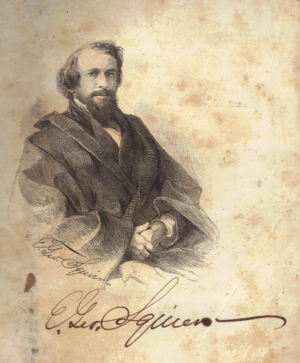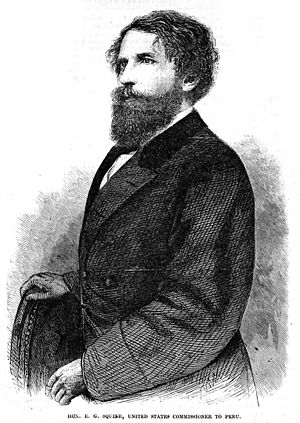E. G. Squier facts for kids
Quick facts for kids
Ephraim George Squier
|
|
|---|---|

Ephraim George Squier
|
|
| Born | June 17, 1821 |
| Died | April 17, 1888 (aged 66) |
| Nationality | American |
| Scientific career | |
| Fields | Archaeology |
Ephraim George Squier (born June 17, 1821 – died April 17, 1888) was an American archaeologist, writer, painter, and newspaper editor. He is often called E. G. Squier. He is famous for his important work studying ancient cultures, especially the Mound Builders of North America and the Inca in Peru.
Contents
Discovering Ancient Cultures
Ephraim George Squier was born in Bethlehem, New York. His father was a minister. When he was young, he worked on a farm and went to school. He also taught at schools. He was very interested in engineering and old American historical sites.
Because of tough economic times, he decided to work in journalism. He helped publish a newspaper in Albany, New York, from 1841 to 1842. Later, he worked as a journalist in Hartford, Connecticut. From 1843 to 1848, he edited the Scioto Gazette newspaper in Chillicothe, Ohio.
Studying the Mound Builders
While in Ohio, Squier worked with a doctor named Edwin H. Davis. Together, they wrote a very important book called Ancient Monuments of the Mississippi Valley. This book was published in 1848. It was a huge step forward for American science. It was the first detailed study of the prehistoric Mound Builders of North America. This work also helped archaeology become a real scientific field.
Their book was the first one ever published by the Smithsonian Institution. Squier and Davis were very careful in how they studied and recorded the ancient sites. They discovered the Serpent Mound in Ohio in 1846. They also mapped the Mound City Group in Chillicothe, Ohio. Today, this site has been rebuilt using their maps and is now part of Hopewell Culture National Historical Park. The ancient objects they collected are now kept in the British Museum in London.
Exploring Central and South America
In 1849, Squier was chosen to be a special diplomat for the United States in Central America. He helped create treaties with countries like Nicaragua, Honduras, and San Salvador.
He visited Central America again in 1853. This time, he looked for a possible route for a railroad across the land. He also continued his studies of the ancient cultures there. In 1856, he received an award from the French Geographical Society for his research.
Around 1860, Squier became the editor-in-chief for Frank Leslie's publishing company. He oversaw the first two volumes of Frank Leslie's Pictorial History of the American Civil War.
In 1863, Squier was appointed as a U.S. commissioner to Peru. There, he did a lot of research on the ancient Inca civilization. He took many photographs of their ruins. He later gave a series of lectures about "The Inca Empire."
Later Life and Legacy
In 1868, he became the consul-general for Honduras in New York. In 1871, he was elected the first president of the Anthropological Institute of New York. He continued to study different cultures, especially in Nicaragua, Honduras, and Peru.
After returning from Peru, he kept working for Frank Leslie. However, his health started to decline. In 1874, his health became very poor, which stopped him from doing more research. He later recovered enough to finish his book about Peru. He was a member of many historical and scientific groups. He passed away in Brooklyn, New York, in 1888.
Books and Publications
E. G. Squier wrote many official reports, scientific papers, and magazine articles. He also contributed to the Encyclopædia Britannica. Here are some of his main books:
- Ancient Monuments of the Mississippi Valley (1848)
- Aboriginal Monuments of the State of New York (1849)
- Serpent Symbols (1852)
- Nicaragua: its People, Scenery, Monuments, and the Proposed Interoceanic Canal (2 volumes, 1852)
- Notes on Central America (1854)
- Waikna, or Adventures on the Mosquito Shore (1855)
- The States of Central America (1857; revised in 1870)
- Monographs of Authors who have written on the Aboriginal Languages of Central America (1860)
- Tropical Fibres and their Economic Extraction (1861)
- Peru: Incidents of Travel and Exploration in the Land of the Incas (1877)


